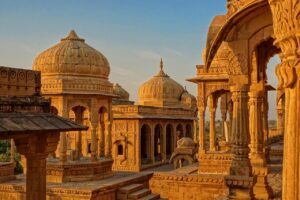Most people visit the Grand Canyon for the insane views and world-class hiking, but if that’s all you’re looking for, you’re only scratching the surface. In this post, we will be uncovering the native American history in the Grand Canyon.
This place isn’t just a geological wonder; it’s also home to ancient sites that tell the story of the Native American cultures who’ve lived here for thousands of years.
Literally thousands.
If you’re planning a trip to the canyon, here’s why you should take a little detour into the past and where to find the ancient footprints still etched into this epic landscape. So, without any further delay, let’s get started with the unveiling of the native American history in the Grand Canyon.
By the way, if you are a first-timer or looking for a complete guide which answers all your hows and whys for visiting the Grand Canyon. Then, do check out this post: A First-Timer’s Guide to Visiting the Grand Canyon
Exploring Native American History in the Grand Canyon
1. Tusayan Ruins
Just off Desert View Drive on the South Rim, the Tusayan Ruins and Museum is a great place to start. The ruins are about 800 years old and give you a peek into a small ancestral Puebloan village, complete with living quarters, storage rooms, and a ceremonial kiva.
It’s a quick, easy walk (perfect for families or if you’re short on time), and the museum adds a ton of context with artefacts, maps, and info on the area’s Native peoples.
2. Petroglyphs & Pictographs
As you hike deeper into the canyon, especially along the Bright Angel Trail or into Havasu Canyon, keep your eyes peeled. Petroglyphs (carved rock art) and pictographs (painted symbols) appear on cliff walls throughout the park.
Some of these markings go back 4,000+ years and offer glimpses into spiritual beliefs, rituals, and everyday life. Bring a zoom lens if you’re into photography, and always resist the urge to touch. These images are incredibly delicate and irreplaceable.
3. Nankoweap Granaries
One of the most remote (and rewarding) sites is the Nankoweap Granaries, carved high into a cliffside above the Colorado River. Built over 1,000 years ago by ancestral Puebloans, these tiny storage rooms held corn and seeds to keep communities going through tough seasons.
Getting there isn’t easy; it’s one of the most challenging hikes in the canyon, but if you’re up for it, the views and sense of connection to the past are unreal.
Modern Tribes, Living Traditions
The Grand Canyon isn’t just a historical site, it’s a living cultural landscape. Eleven Native American tribes maintain deep ties to the region, including the Hopi, Navajo, Hualapai, Havasupai, and Zuni peoples. Many still hold ceremonies, protect sacred spaces, and share stories passed down through generations.
Consider booking a cultural tour with a Native guide for a deeper, more personal experience. It’s a powerful way to see the canyon through the eyes of those who know it best.
Quick Tips for Respectful Exploration of native American history in the Grand Canyon
– Look, don’t touch – especially around ruins and rock art.
– Stay on marked trails – both for your safety and out of respect for sacred spaces.
– Take your time – don’t rush past the quiet places. Let the stillness speak.
Conclusion
The Grand Canyon is more than just a bucket-list destination.
It’s a place where ancient history and natural beauty collide most unforgettably.
So next time you’re staring out at that mile-deep chasm, take a moment to imagine the people who once walked those cliffs, carved those stones, and built their lives in one of the most dramatic settings on Earth.
FAQs =》
Q1. Are the ancient Native American sites open to the public?
Ans. Many are accessible, like the Tusayan Ruins on the South Rim. However, some areas, especially those that are sacred or on tribal land, may be restricted. Always check with the National Park Service or local tribes before visiting less-travelled sites.
Q2. Do I need a permit to visit these sites?
Ans. For places within Grand Canyon National Park, you generally don’t need a special permit unless you’re backcountry hiking or camping. If you’re visiting tribal lands (like Havasupai Falls), permits and advance reservations are definitely required.
Q3. Can I take photos of petroglyphs or ruins?
Ans. Yes, just don’t touch them or use flash. Always photograph respectfully, especially in sacred spaces or on guided tours where photography may be restricted.
Q4. Are there Native-led tours available?
Ans. Yes. There are several tour companies run by members of local tribes. These offer a much deeper understanding of the sites, the history, and the spiritual connection many Indigenous people still have with the canyon.
Q5. What’s the best time of year to visit?
Ans. Spring (April–June) and fall (September–October) are ideal. The weather is mild, the trails are more manageable, and you’ll avoid the extreme summer heat.
Q6. Is it okay to explore off-trail to find ruins or petroglyphs?
Ans. Not recommended. Off-trail travel can damage fragile ecosystems and disturb sacred or protected sites. Stick to marked paths and guided tours.
Q7. What should I pack for visiting these sites?
Ans. Good hiking shoes, water (lots of it), sun protection, a camera, and a curious mind. If you’re heading into remote areas, bring a map or GPS and let someone know your plans.

